The share of gross mortgage advances for buy-to-let (BTL) purposes, including house purchase, remortgage and further advance, decreased by 0.7% in the previous quarter, now standing at 7.5%, the lowest figure since Q3 2010, the Bank of England (BoE) has revealed.
In the BoE’s mortgage lender statistics, it was revealed that the share of BTL mortgage advances had also fallen by five percentage points year-on-year.
Furthermore, the value of new mortgage commitments, which is lending agreed to be advanced in the coming months, decreased by 16.5% in the previous quarter to £51.5bn. This is also 41.1% lower than a year previously.
However, the value of gross mortgage advances increased by 18.6% from the previous quarter to £62.2bn. This is the first increase since Q3 2022, but remained over a quarter (27.6%) lower than a year earlier.
Mortgage expert at Quilter, Karen Noye, said: "This morning’s mortgage statistics from the BoE, illustrate quite how much higher interest rates have sent the market into chaos. However, despite these scary figures house prices have yet to tumble and in fact have recently been rebounding. These green shoots may soon be killed off by a winter frost if rates increase again or if there is another economic shock but for now house prices are remaining resilient.
"Elsewhere, unsurprisingly the share of gross mortgage advances for buy-to-let purposes decreased further to the lowest level since 2010 Q3. This demonstrates quite how inhospitable the tax environment has become for landlords. Many are now choosing to not bother adding to their property portfolios or leave the market altogether as a result."
The data also revealed that the level of mortgage borrowing in arrears in Q3 stood at £18.8bn, up 11.4% in the quarter and 44% year-on-year.
The proportion of total loan balances with arrears, relative to all mortgage balances, rose to 1.14%, the highest since the middle of 2017.
The BoE also highlighted that 15.8% of total outstanding balances were in arrears, down 0.3 percentage points in the quarter, but over five percentage points higher than a year earlier.
Head of personal finance at Hargreaves Lansdown, Sarah Coles, added: "Arrears have reared their ugly heads, with total mortgage arrears up over 10% in a quarter and rising by almost half in a year. As a proportion of the total amount lent in mortgages, it hasn’t been this high since the middle of 2017.
"It’s hitting people with bigger mortgages harder, because while the total amount in arrears is soaring, the total number of borrowers was up less dramatically over the year – and actually fell over the quarter. It reflects how those who stretched their finances to get onto the property ladder, or trade up, are paying a horrible price for it now as their mortgage deals come to an end.
"And the pain is far from over. Given the predominance of fixed rates in the market, the squeeze on our finances caused by sharply higher rates isn’t going to come as a short, sharp shock, but as a nasty squeeze on a small section of the mortgage market each month, over a horribly prolonged period of time."
Latest News
-
Borrowers jumped gun ahead of December rate cut – Twenty7tec
-
FCA stops Verus Financial Services from conducting regulated activities
-
IHT receipts reach £5.8bn in eight months to November
-
Perspective Financial Group acquires Prosser Knowles
-
Over half of UK savers relying on non-pension assets for retirement
-
Bank of England cuts interest rates to 3.75%
Perenna and the long-term fixed mortgage market

Content editor, Dan McGrath, spoke to head of product, proposition and distribution at Perenna, John Davison, to explore the long-term fixed mortgage market, the role that Perenna plays in this sector and the impact of the recent Autumn Budget
The role of the bridging market and technology usage in the industry
Content editor, Dan McGrath, sat down with chief operating officer at Black & White Bridging, Damien Druce, and head of development finance at Empire Global Finance, Pete Williams, to explore the role of the bridging sector, the role of AI across the industry and how the property market has fared in the Labour Government’s first year in office.
NEW BUILD IN FOCUS - NEW EPISODE OF THE MORTGAGE INSIDER PODCAST, OUT NOW

Figures from the National House-Building Council saw Q1 2025 register a 36% increase in new homes built across the UK compared with the same period last year, representing a striking development for the first-time buyer market. But with the higher cost of building, ongoing planning challenges and new and changing regulations, how sustainable is this growth? And what does it mean for brokers?
Does the North-South divide still exist in the UK housing market?

What do the most expensive parts of the country reveal about shifting demand? And why is the Manchester housing market now outperforming many southern counterparts?
In this episode of the Barclays Mortgage Insider Podcast, host Phil Spencer is joined by Lucian Cook, Head of Research at Savills, and Ross Jones, founder of Home Financial and Evolve Commercial Finance, to explore how regional trends are redefining the UK housing, mortgage and buy-to-let markets.
In this episode of the Barclays Mortgage Insider Podcast, host Phil Spencer is joined by Lucian Cook, Head of Research at Savills, and Ross Jones, founder of Home Financial and Evolve Commercial Finance, to explore how regional trends are redefining the UK housing, mortgage and buy-to-let markets.
© 2019 Perspective Publishing Privacy & Cookies










Recent Stories